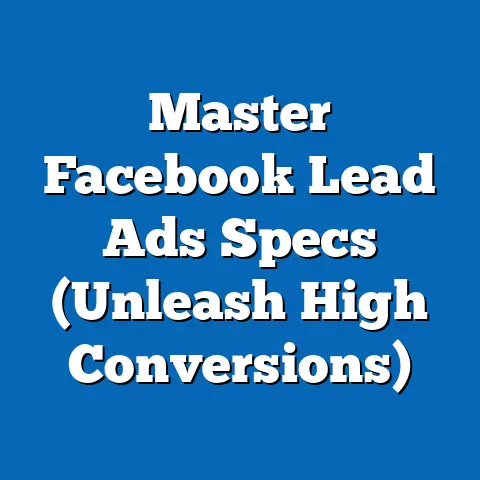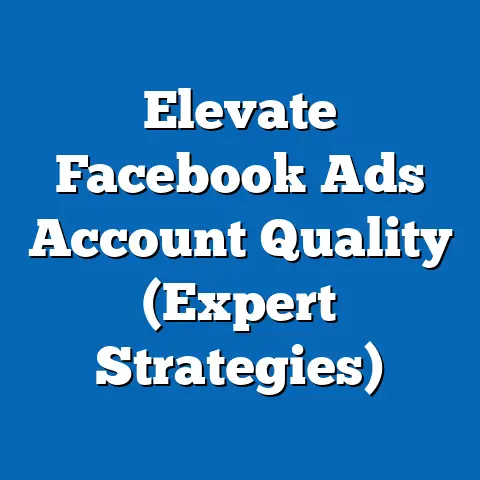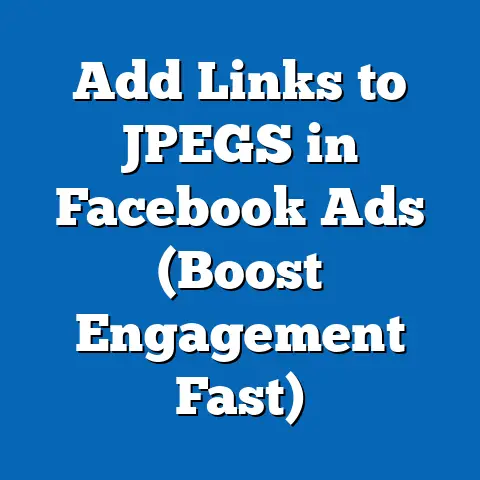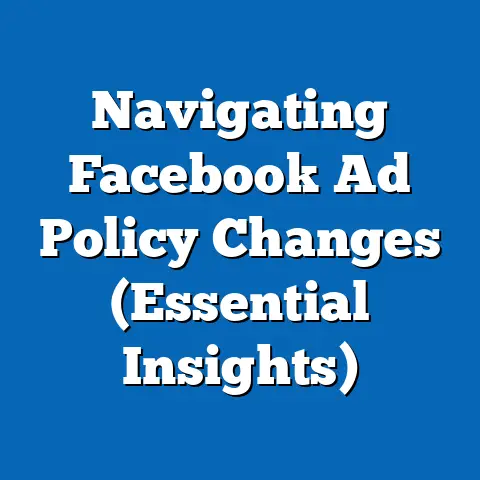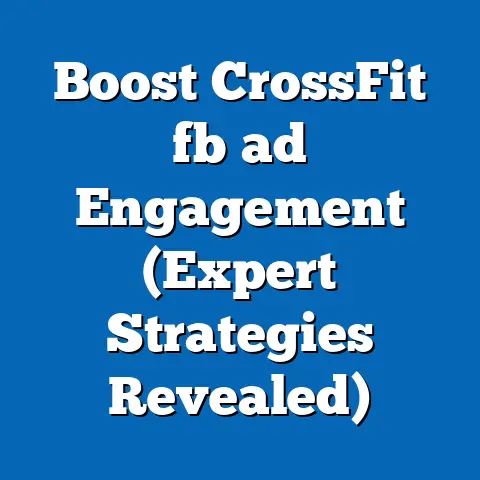Navigating Facebook’s Alcohol Ad Policies (Expert Insights)
Many believe that advertising alcohol on Facebook is straightforward and unrestricted, but the reality is far more complex. As someone who’s spent years crafting and optimizing Facebook ad campaigns, I can tell you that the alcohol industry faces unique hurdles. Facebook’s advertising policies can feel like a labyrinth, especially when dealing with sensitive products like alcohol. It’s crucial to understand these policies to avoid ad disapprovals, account restrictions, and, ultimately, wasted ad spend. This article provides the expert insights you need to navigate Facebook’s alcohol ad policies effectively, ensuring your campaigns are both compliant and successful.
Section 1: Overview of Facebook’s Alcohol Ad Policies
Facebook’s advertising policies regarding alcohol are designed to protect users, particularly those under the legal drinking age. They aim to promote responsible advertising and prevent the glamorization of excessive alcohol consumption. These policies aren’t just suggestions; they are enforced rigorously. I’ve seen countless campaigns get flagged for seemingly minor infractions. So, what exactly do these policies entail?
First and foremost, age restrictions are paramount. Facebook requires advertisers to target users who meet the minimum drinking age in the country or region where the ad is being shown. This means carefully selecting your target audience based on age and location. I remember once working with a client who was launching a new craft beer. We meticulously set up age and location targeting, but a small oversight in excluding a specific region with a higher drinking age led to the entire campaign being paused. It was a costly lesson in attention to detail.
Beyond age, Facebook also has specific rules about the content of your ads. You can’t depict or encourage excessive alcohol consumption, portray it as a solution to personal problems, or associate it with driving or operating machinery. Ads must also avoid appealing to minors, which means no cartoon characters, childish themes, or language that would resonate more with younger audiences.
Here’s a breakdown of what’s generally permitted and prohibited:
Permitted (with restrictions):
- Images of the alcoholic beverage itself.
- Ads promoting responsible drinking.
- Ads for alcohol-related events (e.g., wine tastings, brewery tours).
- Ads highlighting the quality or craftsmanship of the product.
Prohibited:
- Content that encourages excessive drinking.
- Imagery of people who appear to be intoxicated.
- Claims that alcohol has health benefits.
- Ads targeting individuals under the legal drinking age.
- Content that associates alcohol with dangerous activities.
It’s also crucial to remember that Facebook’s policies are often layered on top of local laws and regulations. In some regions, you may need to obtain special permits or licenses to advertise alcohol. For instance, in certain states in the US, you might need to include specific disclaimers or warnings in your ads. Failing to comply with these local requirements can result in severe penalties, including legal action.
According to a 2023 report by Statista, social media advertising spending in the alcoholic beverage industry reached $2.8 billion globally. This illustrates the significant investment in this space, but it also highlights the importance of navigating the regulatory landscape effectively. You don’t want to be a statistic of wasted ad spend due to policy violations.
Key Takeaway: Facebook’s alcohol ad policies are multifaceted and require a thorough understanding of both the platform’s rules and local regulations. Age targeting is critical, and the content of your ads must promote responsible consumption and avoid appealing to minors.
Section 2: Common Challenges in Alcohol Advertising on Facebook
Even with a solid understanding of the policies, advertising alcohol on Facebook presents several unique challenges. I’ve seen even seasoned marketers stumble when it comes to these nuanced restrictions.
One of the most significant hurdles is accurate audience targeting. While you can target users based on age and location, ensuring that you’re only reaching individuals of legal drinking age can be tricky. False profiles and inaccurate self-reported data can lead to ads being shown to underage users, resulting in policy violations.
Another challenge is avoiding content that might be deemed inappropriate. What constitutes “inappropriate” can be subjective and open to interpretation. Facebook’s algorithms are constantly evolving, and sometimes they flag ads that seem perfectly innocuous. I once had an ad rejected because it showed people clinking glasses at a wedding. The algorithm interpreted this as promoting excessive drinking, even though the ad’s message was about celebrating responsibly.
Compliance with age restrictions is also a constant concern. Facebook relies on users’ self-reported age data, which isn’t always accurate. Additionally, even if you set your age targeting correctly, ads can still be seen by underage users if they’re shared or viewed by friends who are below the legal drinking age.
Here’s a closer look at these challenges:
Furthermore, many marketers struggle with balancing creativity and compliance. You want to create ads that are engaging and memorable, but you also need to ensure that they adhere to Facebook’s strict guidelines. This often requires a delicate balancing act.
Expert Insight: “The key to navigating these challenges is to be proactive and meticulous,” says Sarah Jones, a digital marketing consultant specializing in the alcohol industry. “Thoroughly review Facebook’s policies, consult with legal experts if necessary, and continuously monitor your campaigns for compliance.”
Key Takeaway: Alcohol advertising on Facebook presents unique challenges related to audience targeting, content moderation, and compliance with local regulations. Proactive monitoring and meticulous attention to detail are essential for avoiding policy violations.
Section 3: Best Practices for Creating Compliant Alcohol Ads
Creating compliant alcohol ads on Facebook requires a strategic approach that balances creativity with adherence to policy. I’ve developed a set of best practices over the years that have helped me navigate these complexities successfully.
1. Master Audience Targeting:
- Layered Targeting: Don’t rely solely on age and location. Use demographic and interest-based targeting to refine your audience. For example, target users who are interested in wine clubs, craft beer festivals, or specific types of alcohol.
- Custom Audiences: Create custom audiences based on your existing customer data. This allows you to target users who have already shown an interest in your brand.
- Exclusion Targeting: Exclude users who are likely to be underage or who have expressed an aversion to alcohol-related content.
2. Craft Responsible Messaging:
- Focus on Quality and Craftsmanship: Highlight the unique qualities of your product, such as its ingredients, brewing process, or aging techniques.
- Promote Responsible Consumption: Include messages that encourage moderation and responsible drinking habits.
- Avoid Glamorizing Alcohol: Steer clear of imagery or language that portrays alcohol as a solution to personal problems or as a status symbol.
3. Optimize Visual Content:
- Use High-Quality Imagery: Choose images that are visually appealing and that accurately represent your product.
- Avoid Depicting Intoxication: Do not show people who appear to be drunk or who are engaging in risky behavior.
- Comply with Age Restrictions: Ensure that your visual content does not appeal to underage users.
4. Implement Age Verification:
- Use Facebook’s Age Verification Tools: Take advantage of Facebook’s built-in age verification tools to ensure that your ads are only being shown to users of legal drinking age.
- Require Age Verification on Your Website: If you’re driving traffic to your website, implement age verification measures to ensure that users are of legal drinking age before they can access alcohol-related content.
5. Monitor and Optimize Continuously:
- Track Key Metrics: Monitor your ad performance closely, paying attention to metrics such as reach, engagement, and conversion rates.
- A/B Test Your Ads: Experiment with different ad creatives, targeting options, and messaging to see what resonates best with your audience.
- Stay Up-to-Date on Facebook’s Policies: Facebook’s advertising policies are constantly evolving, so it’s essential to stay informed about the latest changes.
For example, a distillery I worked with recently launched a Facebook campaign promoting their new line of premium whiskeys. We used layered targeting to reach affluent adults who were interested in whiskey tastings and fine dining. The ads featured high-quality imagery of the whiskey bottles and highlighted the distillery’s history and craftsmanship. We also included a message encouraging responsible consumption. The campaign was a resounding success, generating a significant increase in website traffic and online sales.
Expert Recommendation: “Testing different ad variations is crucial. Try different images, headlines, and calls-to-action to see what resonates best with your target audience while staying within the bounds of Facebook’s policies,” advises David Lee, a marketing director for a major brewery.
Key Takeaway: Creating compliant alcohol ads on Facebook requires a strategic approach that includes mastering audience targeting, crafting responsible messaging, optimizing visual content, implementing age verification, and monitoring your campaigns continuously.
Section 4: The Future of Alcohol Advertising on Facebook
The landscape of alcohol advertising on social media is constantly evolving, influenced by changing regulations, consumer attitudes, and digital marketing trends. I believe that the future of alcohol advertising on Facebook will be shaped by several key factors.
1. Increased Regulation:
- Growing Scrutiny: Regulators are paying closer attention to alcohol advertising on social media, particularly its potential impact on underage users.
- Stricter Enforcement: Facebook is likely to face increasing pressure to enforce its advertising policies more rigorously.
- New Legislation: We may see new laws and regulations that further restrict alcohol advertising on social media.
2. Changing Consumer Attitudes:
- Health Consciousness: Consumers are becoming more health-conscious and are increasingly aware of the risks associated with excessive alcohol consumption.
- Demand for Transparency: Consumers are demanding greater transparency from alcohol brands, including information about ingredients, production methods, and responsible drinking practices.
- Shift Towards Moderation: There’s a growing trend towards moderation and mindful drinking, with more people opting for low-alcohol or non-alcoholic beverages.
3. Emerging Digital Marketing Trends:
- Personalized Advertising: Facebook’s advanced targeting capabilities will enable advertisers to deliver more personalized and relevant ads to individual users.
- Interactive Experiences: We may see more alcohol brands experimenting with interactive ad formats, such as quizzes, polls, and augmented reality experiences.
- Influencer Marketing: Influencer marketing will continue to be a popular strategy for alcohol brands, but it will be subject to greater scrutiny and regulation.
4. Potential New Features from Facebook:
- Enhanced Age Verification: Facebook may introduce new age verification tools that are more accurate and reliable.
- Compliance Assistance: Facebook could provide advertisers with more resources and guidance to help them create compliant alcohol ads.
- Responsible Drinking Campaigns: Facebook might partner with alcohol brands to launch campaigns that promote responsible drinking habits.
Industry Expert Insight: “The future of alcohol advertising on Facebook will be about striking a balance between promoting your product and demonstrating a commitment to responsible consumption,” says Emily Carter, a social media strategist specializing in the beverage industry. “Brands that prioritize transparency, moderation, and ethical marketing practices will be the most successful.”
I predict that Facebook will continue to refine its advertising policies and introduce new tools to help advertisers comply with regulations. Brands that are proactive in adapting to these changes and that prioritize responsible marketing practices will be best positioned for success.
Key Takeaway: The future of alcohol advertising on Facebook will be shaped by increased regulation, changing consumer attitudes, emerging digital marketing trends, and potential new features from Facebook. Staying informed and adapting to these changes will be crucial for alcohol brands that want to thrive on the platform.
Conclusion
Navigating Facebook’s alcohol ad policies can feel like a complex and daunting task, but it’s essential for any business operating in the alcohol sector. By understanding the platform’s rules, mastering audience targeting, crafting responsible messaging, and staying informed about evolving trends, you can create compliant and effective campaigns that drive results.
Remember, the key to success is to stay informed, be proactive, and prioritize responsible marketing practices. Don’t just aim to sell your product; aim to build a brand that is trusted and respected by consumers.
The potential for success in alcohol advertising on Facebook is immense, but it requires a thoughtful and strategic approach. When done correctly, you can reach a vast audience, build brand awareness, and drive sales, all while adhering to Facebook’s strict guidelines and promoting responsible consumption. So, take the insights and strategies outlined in this article, apply them to your campaigns, and watch your business thrive.

